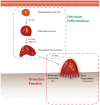The emerging role of osteoclasts in the treatment of bone metastases: rationale and recent clinical evidence
- PMID: 39148909
- PMCID: PMC11324560
- DOI: 10.3389/fonc.2024.1445025
The emerging role of osteoclasts in the treatment of bone metastases: rationale and recent clinical evidence
Abstract
The occurrence of bone metastasis is a grave medical concern that substantially impacts the quality of life in patients with cancer. The precise mechanisms underlying bone metastasis remain unclear despite extensive research efforts, and efficacious therapeutic interventions are currently lacking. The ability of osteoclasts to degrade the bone matrix makes them a crucial factor in the development of bone metastasis. Osteoclasts are implicated in several aspects of bone metastasis, encompassing the formation of premetastatic microenvironment, suppression of the immune system, and reactivation of quiescent tumor cells. Contemporary clinical interventions targeting osteoclasts have proven effective in mitigating bone-related symptoms in patients with cancer. This review comprehensively analyzes the mechanistic involvement of osteoclasts in bone metastasis, delineates potential therapeutic targets associated with osteoclasts, and explores clinical evidence regarding interventions targeting osteoclasts.
Keywords: antiresorptive drugs; bone metastasis; osteoclasts; targeted therapy; therapeutic targets.
Copyright © 2024 Liu, Chen, Chen, Qiu and Han.
Conflict of interest statement
The authors declare that the research was conducted in the absence of any commercial or financial relationships that could be construed as a potential conflict of interest.
Figures
Similar articles
-
The Osteoclast in Bone Metastasis: Player and Target.Cancers (Basel). 2018 Jun 27;10(7):218. doi: 10.3390/cancers10070218. Cancers (Basel). 2018. PMID: 29954079 Free PMC article. Review.
-
Molecular pathogenesis of bone metastases in breast cancer: Proven and emerging therapeutic targets.World J Clin Oncol. 2014 Aug 10;5(3):335-47. doi: 10.5306/wjco.v5.i3.335. World J Clin Oncol. 2014. PMID: 25114849 Free PMC article. Review.
-
Targeted Agents in Preclinical and Early Clinical Development for the Treatment of Cancer Bone Metastases.Expert Opin Investig Drugs. 2016;25(3):319-34. doi: 10.1517/13543784.2016.1142972. Epub 2016 Feb 6. Expert Opin Investig Drugs. 2016. PMID: 26778342 Review.
-
RSPO2 and RANKL signal through LGR4 to regulate osteoclastic premetastatic niche formation and bone metastasis.J Clin Invest. 2022 Jan 18;132(2):e144579. doi: 10.1172/JCI144579. J Clin Invest. 2022. PMID: 34847079 Free PMC article.
-
Heterogeneity of tumor cells in the bone microenvironment: Mechanisms and therapeutic targets for bone metastasis of prostate or breast cancer.Adv Drug Deliv Rev. 2016 Apr 1;99(Pt B):206-211. doi: 10.1016/j.addr.2015.11.017. Epub 2015 Dec 4. Adv Drug Deliv Rev. 2016. PMID: 26656603 Review.
Cited by
-
MicroRNAs and RNA-Binding Protein-Based Regulation of Bone Metastasis from Hepatobiliary Cancers and Potential Therapeutic Strategies.Cells. 2024 Nov 21;13(23):1935. doi: 10.3390/cells13231935. Cells. 2024. PMID: 39682684 Free PMC article. Review.
-
From Bench to Bedside in Emerging Therapies for Gynecological Malignancies: A Narrative Review.Cancer Control. 2025 Jan-Dec;32:10732748251357158. doi: 10.1177/10732748251357158. Epub 2025 Jul 6. Cancer Control. 2025. PMID: 40619274 Free PMC article. Review.
-
Biomarker-Driven Approaches to Bone Metastases: From Molecular Mechanisms to Clinical Applications.Biomedicines. 2025 May 10;13(5):1160. doi: 10.3390/biomedicines13051160. Biomedicines. 2025. PMID: 40426987 Free PMC article. Review.
-
27-Hydroxycholesterol in cancer development and drug resistance.J Enzyme Inhib Med Chem. 2025 Dec;40(1):2507670. doi: 10.1080/14756366.2025.2507670. Epub 2025 May 22. J Enzyme Inhib Med Chem. 2025. PMID: 40401382 Free PMC article. Review.
References
-
- Galasko CS. Monitoring of bone metastases. Schweiz Med Wochenschr. (1981) 111:1873–5. - PubMed
Publication types
LinkOut - more resources
Full Text Sources



